Article
Should American Tourists Make Their Own Exit from Europe? Part 9
Author(s):
Germany is up next for exploration of European countries in the series, "Should American Tourists Make Their Own Exit from Europe?"
*All photography by the author
One country lies dominantly today plumb in the center of Europe: Germany — and it has made the most successful recovery of any European country after World War II, an astonishing fact for anyone who does not understand German efficiency. Germans can be the hardest workers on the continent.
In 1950, as a young Selective Service infantry second lieutenant in the BAOR (the British Army of the Rhine), I was leading my platoon on the monthly obligatory 21 mile-night march when we heard mechanical noises ahead of us around the bend of a rural road.
We were approaching bright lights. “Tanks!” our point man shouted. But we were in Allied-occupied Germany. We were infantry. Our Royal Scots Fusiliers regiment didn’t have tanks.
We marched round the bend in the middle of the night to find a scene that would become normal those post-war years in Germany. Cars were lined up facing each other along the town’s main street. Lights ablaze they were illuminating a frantic scene as the town people (which included children) bent their backs to rebuild their ruined town. It was hard work. Nobody was complaining. They were rebuilding their future.
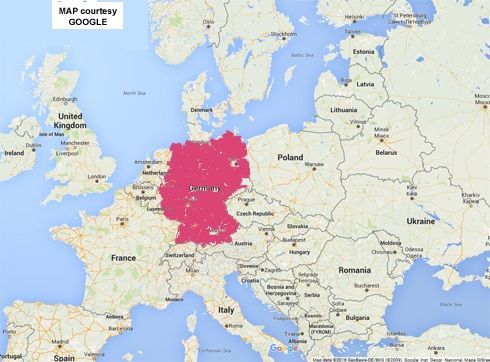
Berlin, in particular, shows the face of reconstruction yet much has survived World War II: Five magnificent buildings, some rebuilt at Museum Island have one of the world’s greatest collections. I was particularly pleased to get into the Pergamonmuseum with the Altar of Zeus that was carried off in 1876 from the second century AD gladiator workplace of Galen by the meticulous German engineer and self-educated archaeologist, Carl Humann. It is now the center of a huge architectural effort that may keep it closed to the public till 2019. Verify it is open before you buy an admission ticket.
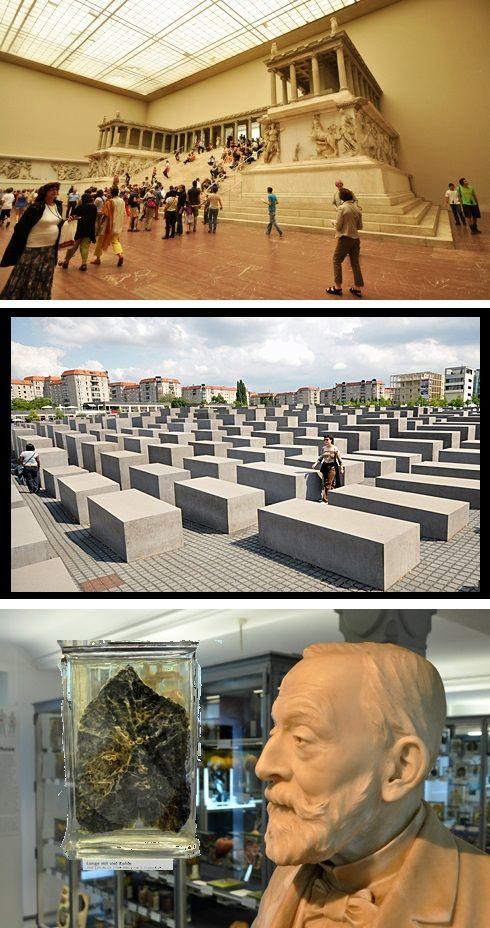
The vast Pergamon Altar. Tribute to the Murdered Jews of Europe. For a personal New Yorker magazine opinion of this memorial click here. Pathological specimens of laboratory of Rudolf Ludwig Karl Virchow who, born in 1821, may be the greatest pathologist who ever looked down a microscope.
Berlin is a natural place to visit first in Germany. But what then? Given that working professionals in the United States don’t have the long paid-vacations of the Europeans, what is worth doing now? Well, the German National Tourist Office has some suggestions for you; actually a lot of suggestions, as if wanting you to know it is the most efficient and helpful of any tourist organizations in Europe. It is so well organized and its offices are so helpful that you could almost confine your first visit to Europe to Germany and come back the next year to see what remains elsewhere. (Amongst travel writers the GNTO — click here for the NYC office — is legendary.)
Suggestions for Travel in Germany
I have found the Germany “Off the Beaten Track” website tremendously useful. Its map shows its 14 small cities: Augsburg, Erfurt, Freiburg, Heidelberg, Koblenz, Mainz, Muenster, Osnabrueck, Potsdam, Regensburg, Rostock, Wiesbaden and Wuerzburg including Trier, one of Europe’s oldest cities (see my Trier images and map with the city locations).
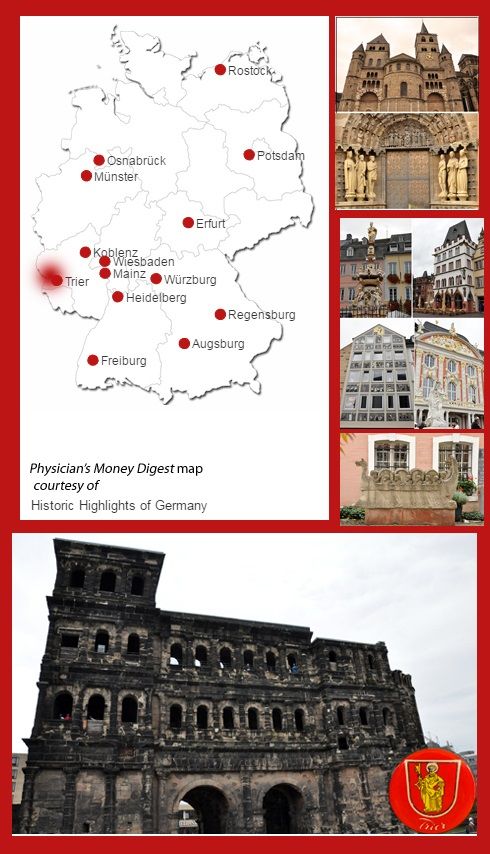
Historic Highlights of Germany cities showing Trier in particular, an old Roman city.

Some of the cities on the map are more famous than others. Mainz, for example, celebrated for its wines and marvelous Marc Chagall stained glass window (the last artistic piece Chagall created just before he died in 1985 aged 97 — and for which he invented eight separate shades of blue; and the site where Gutenberg printed his famous Bible in 1450). Our guide, Judith Konig, a certified printing demonstrator at the Gutenberg Museum, prints the first page of the Bible for us on Gutenberg’s own printer.

Heidelberg is possibly as much famous for Sigmund Romberg’s operetta The Student Prince as for its much admired university. The 1954 movie of the operetta offered the voice of Mario Lanza (who had been sensational in the Great Caruso 1951 movie) who outshined, in my opinion, the performance of the actor he sang for, Edmond Purdon. We meet our guide, Susanne Fiek, a cheerful blonde who offers us a copy of her book Heidelberg on Foot written in German. We go to the Castle, the home of the world’s largest wine barrel (58 thousand gallons). We shoot our customary images as she reaches to point at a gigantic barrel. She laughs and says, “There are two barrels; this is the smaller one.” We head to the student haunt, The Red Ox with its framed autographs by those famous American travelers, John Wayne and Marilyn Monroe but scribbled on different dates. They were not traveling together!
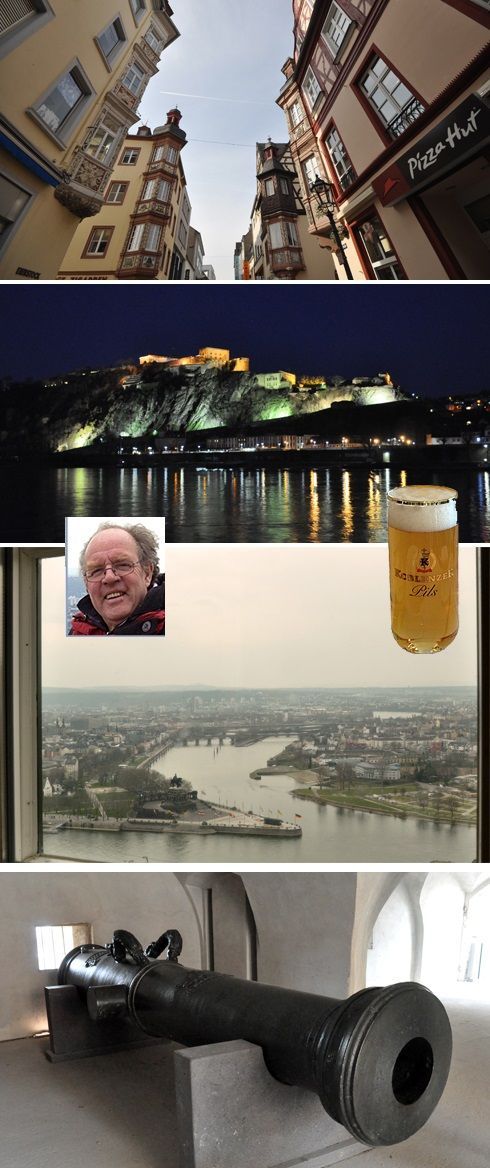
It’s hard not to find Koblenz on your destination list. It’s easily reached by car or train and especially by river boat as it lies on the junction of the Rhine and the Moselle. Our guide Gerd Reis not only spoke fluent English, but with a Scotsman as a friend, could tease a Scottish travel writer like me by assuming a thick Scottish accent. He took us up to the fortress where we saw examples of the artillery that ended the reign of castles.
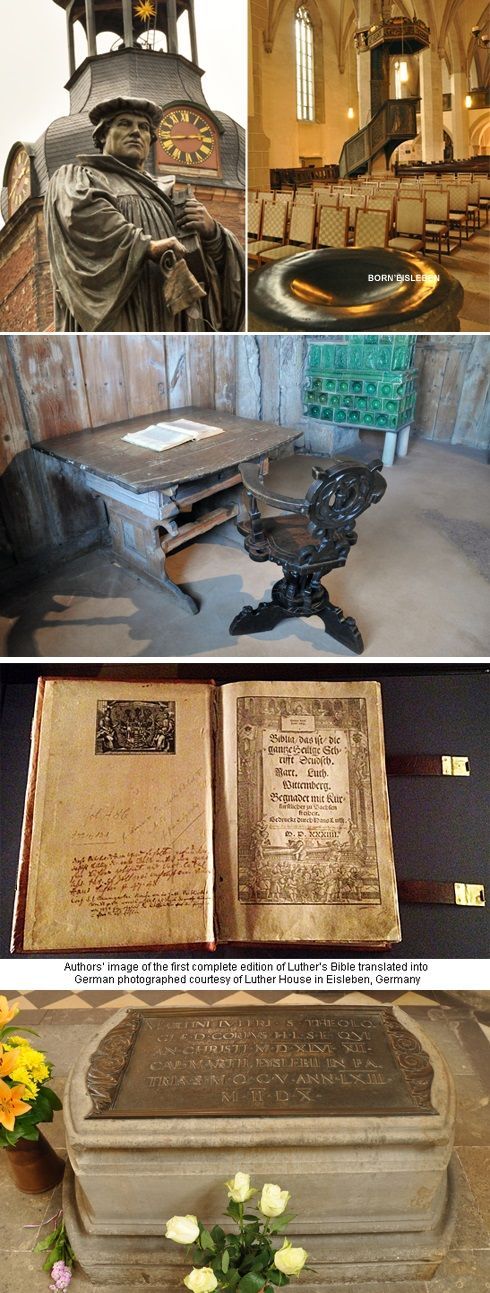
We have also followed the trail of Martin Luther across Germany 500 years after his birth with reference to the detailed notes from the GNT. We went by rail with a DBahn pass fairly easily although sometimes there was a bit of a hike from the station to what we wanted to see. Each stop had some impact on Luther’s life from where he was born in Eisleben, to the church door where he nailed his protests to the Pope, to where he hid while he translated the Bible into German, and finally where he was laid to rest. The tours run through 2017.
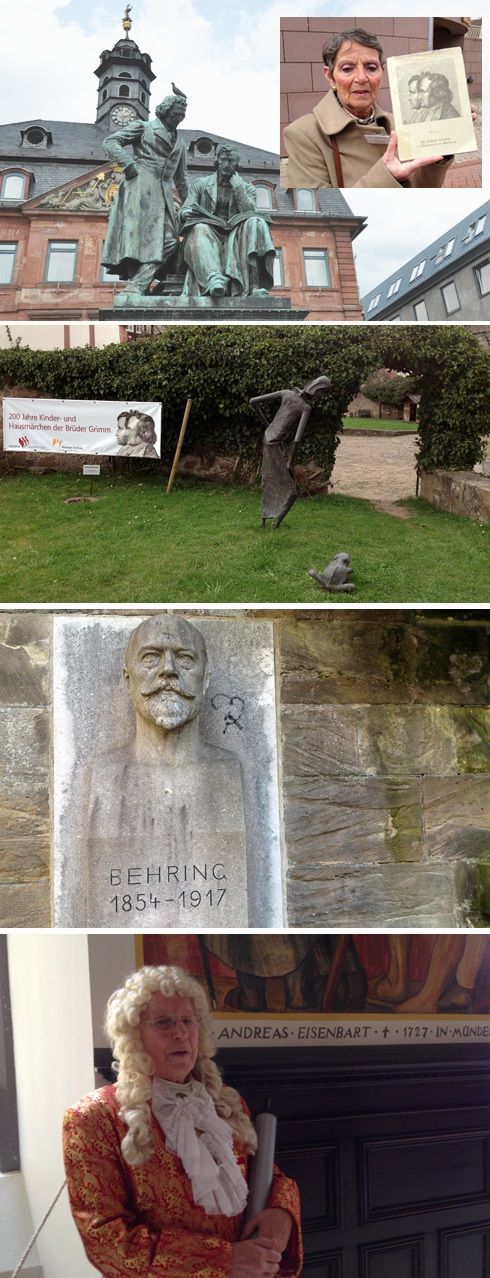
Our GNTO Guide Frau Hoffmann-Meschede was delightfully efficient in leading us through all the German rural sources of the Brothers Grimm stories from where the Brothers were college students to towns that had statuettes commemorating their characters. Knowing our health background, she made sure we saw in Marburg the Emil Adolf von Behring wall statue. She reminded us he developed the vaccine for diphtheria and was awarded the Nobel Prize in 1901. Behring truly lived. But so did the legendary Dr. Eisenbarth whose exploits are all over Hand. Munden, one of the prettiest small towns in Germany. We had a local guide in Hand. Munden, Dr. Gudrun Keindorf who had a Doctorate in Philosophy. “It was like a circus, a carnival when Dr. Eisenbarth came to town,” she said. “He might arrive with more than a hundred musicians, entertainers and assistants and the loud music would drown the cries of pain from his patients. But it’s important to know that the death rate from surgical procedures in those days was about 80 percent and his death rate was 50 percent. People attributed that to his ‘contract with the devil.’” Insiders say he placed his instruments on hot coals postop which may have partly sterilized them.
A local actor plays the part. For more details see our 2013 article here.

The GNTO put us in touch with an extraordinarily generous museum owner, Winfried A. Seidel, the owner of the Dr. Carl Benz Automuseum. He knew of our interest in the events of 120 years ago and could not do enough to help us understand and drive the Bertha Benz Memorial Route. He provided us with two elegant classic Mercedes-Benz automobiles, one to be a chase car and two drivers and sent us on our way. Our story (one of more than 50 stories we have written on German destinations for this magazine can be seen there.)
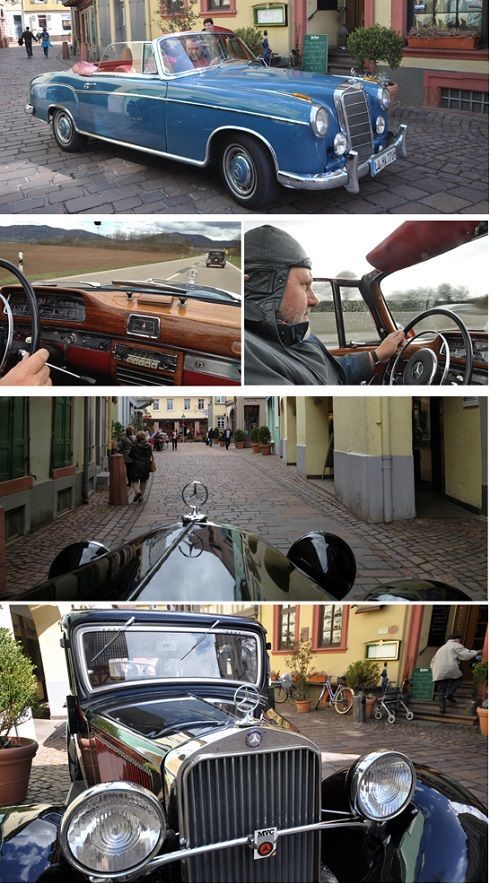
Chase cars
What is an Ex-Brit to think looking back now on a dozen or more contented visits to a country that was his nation’s enemy all through his childhood, a child whose father, born in 1898, lied about his age to join up at the start of World War I and survived the War to End All Wars — and can be remembered bending over an old wireless set in the early days of World War II when no news was good news for the British. Children should be seen but not heard was a common saying in the 1930s. Children knew not to speak when Winston Churchill was intoning solemn details over the BBC network. And yet life moves on. Germany has apologized for what the Nazis did in World War II; Japan in contrast has not
it could not abide the loss of face.
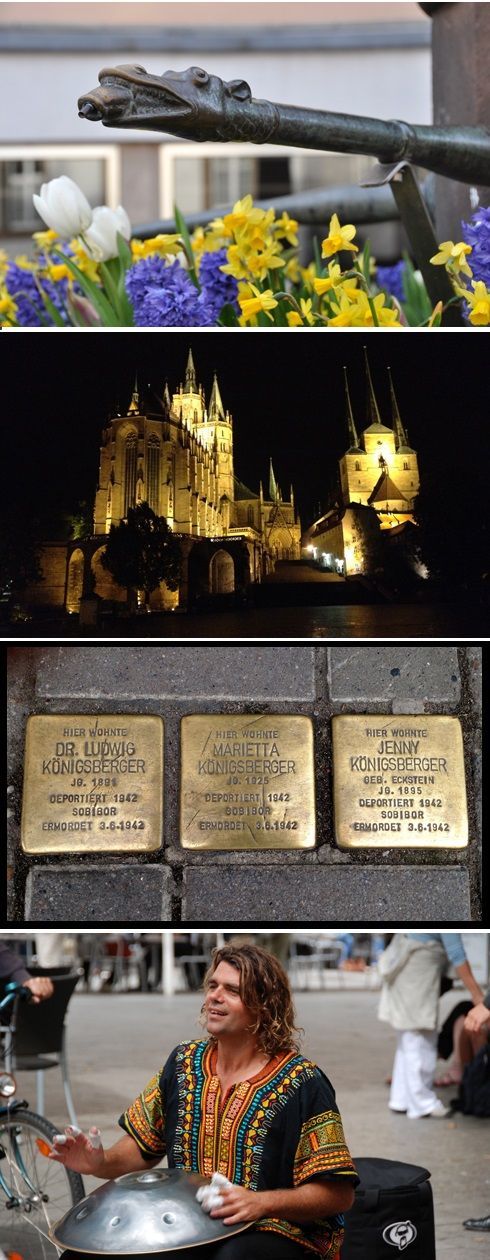
Germany is the easiest country to visit. It is efficient and really strives to help tourists — and it hopes they will become regular visitors. This country has fascinating sculptures, gorgeous Gothic architecture, and its youth seem to have the enthusiasm of a land that has given much to the field of music – and it is most humbling to kick against its “stumble stones,” those countless brass plates that remind people passing by that here, for example, lived the family of 51-year-old Dr. Ludwig Konigsberger. They were all murdered in 1942 for the crime of … being Jewish! The guide, who was not Jewish, drew my attention to the stones. “We hope you will mention them in your articles,” she said, “so the world knows!”
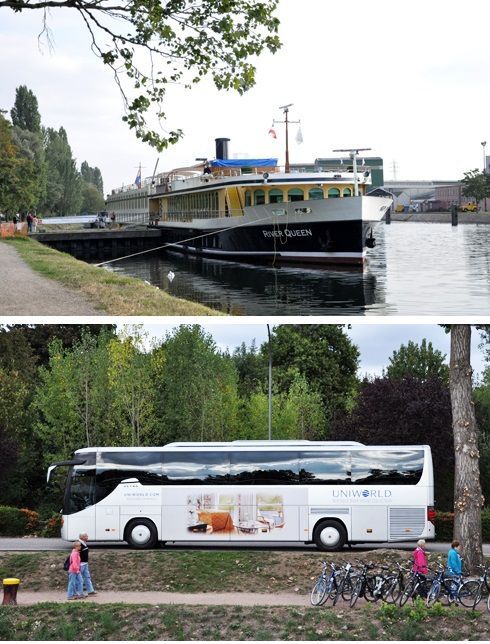
—
There are many ways to explore Germany. Train, car, tour operator, and even Uber! For us, many times, it has been through Uniworld and its river boat cruises. Germany has perhaps the best canals and rivers in Europe, and that has made Uniworld famously successful.
The Andersons, who live in San Diego, are the resident travel & cruise columnists for Physician's Money Digest. Nancy is a former nursing educator, Eric a retired MD. The one-time president of the NH Academy of Family Physicians, Eric is the only physician in the Society of American Travel Writers. He has also written five books, the last called The Man Who Cried Orange: Stories from a Doctor's Life.




